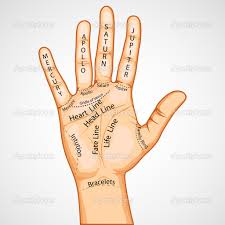Showcase your talents to the world.

Showcase your talents to the world.


If you've always been intuitive and sensitive about people, palm reading or chiromancy could be a satisfying hobby for you. Similar to astrology and numerology, palm reading has been in existence for thousands of years. The science of palm reading is known by several names such as palmistry, chiromancy, or even hand analysis or examination. It is a common, popular and prevalent practice in various parts of the world. Earlier, it was only possible to learn and study the science of palmistry through experts who possessed relevant knowledge and skill on the subject or by reading books. Thanks to modern technology, especially the World Wide Web, it is simpler to learn palm reading now and many people are increasingly getting encouraged to take it up as a hobby.
Palmistry, or chiromancy derived from the Greek word 'kheir' meaning 'hand' and 'manteia' meaning 'divination', is the claim of characterizing, classifying, foretelling and anticipating the future through the study of the palm, also known as palm reading or chirology. This practice is found all over the world with diverse cultural variations. Those who practice chiromancy are generally called palmists, palm readers, hand readers, hand analysts, or chirologists. The conflicting interpretations of various lines and palmar features across several schools of palmistry and the lack of empirical support for palmistry's predictions contribute to palmistry's perception as a pseudoscience among academics.
The practice of palmistry is quite common in the Eurasian landmasses and is still very prevalent today. It was and continues to be an integral part of the cultures of India, Tibet, China, Persia, Sumeria, Ancient Israel and Babylonia. Some believe it had its ancestries in Hindu astrology known as Jyotish in Sanskrit, Yijing in China and Gypsy fortune tellers in Roma. From India, the art of palmistry spread to Tibet, Egypt, Persia and other countries in Europe and to China from where it progressed to Greece where Anaxagoras practiced it. Aristotle discovered a thesis on the subject of palmistry on an altar of Hermes, which he then presented to Alexander the Great, who had curiosity in palmistry and took great interest in examining the character of his officers by analysing the lines on their hands. During the middle Ages the art of palmistry was actively and vigorously suppressed by the Catholic Church as pagan superstitions and was categorised as one of the seven 'forbidden arts'.
From the beginning of time man has always been interested in knowing about the future, anticipating it and analyzing it and tried to find a means to do so. All this interest gave birth to the pseudoscience- palmistry. Palm reading is primarily about understanding a person and deducing conclusions based on the various lines, fingerprints and mounts that are present on the hand. So if you happen to be fascinated and interested in palm reading then you can learn how to do so, and with practice and dedication you can even translate your hobby into a remunerative activity or take it up as a full-time profession.Palmistry has caught on all over the world and more and more people are taking up this hobby to appease their curiosity about the future.
Hobbylancer and You
At Hobbylancer meet other palmists, learn about chiromancy, research on this particular subject and provide readings for interested people. Share your thoughts on palmistry as a science, write articles about it, advertise your own skills and connect with customers from all around the world. Let thy palms do all the talking only at Hobbylancer.